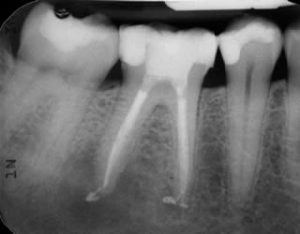Endodontics – An Overview Of Root Canal Treatment In Wickford
Preserving a tooth when the root canals become infected
 At the Cygnet Dental Practice, we always encourage our patients to look after their teeth well to help prevent problems from arising. Preventative dental care is important and we not only encourage this to prevent external damage to the tooth, but to prevent infections occurring in the inner parts of the tooth structure.
At the Cygnet Dental Practice, we always encourage our patients to look after their teeth well to help prevent problems from arising. Preventative dental care is important and we not only encourage this to prevent external damage to the tooth, but to prevent infections occurring in the inner parts of the tooth structure.
One area in particular that is vulnerable to infection when bacteria manages to enter via a crack in the tooth for example, are the root canals. Most of you will have heard of a root canal procedure and we will look at that shortly. Before that though, it is useful for our Wickford patients to understand a little more about this area of the tooth.
What is in the root canals?
The root canals of a tooth contain the dental pulp. This consists of blood vessels, nerves and connective tissue. These are essential for a healthy tooth and are usually well protected by both the dentin and enamel layers that surround it. When the enamel is damaged however, bacteria can enter and make their way through the dentin before reaching the root canals. Once this has happened, invasive treatment will be needed to save the tooth. That is where endodontic treatment comes in.
What can lead to root canal infections?
As mentioned above, infections occur when bacteria finds its way through the enamel and dentin, into the soft pulp of the root canals. This can happen in a number of ways including two of the most common:
Tooth decay – Providing that this isn’t allowed to develop and you have a treatment such as a filling in its earlier stages, your root canals should be protected. Failure to have it treated soon enough can lead to the decay reaching the canals. At this point, a general filling will no longer suffice.
Tooth trauma – A blow to the face, such as might occur playing some sports, could lead to the tooth breaking or becoming fractured. This can expose the inner part of the tooth and lead to infections in the root canals. Even if your teeth look ok after a blow such as this, you should always have it checked at our Wickford dental practice to be on the safe side.
In essence, any damage to the tooth enamel can eventually lead to root canal infections so please make sure that you maintain regular check ups with our friendly dental team.
The procedure
You will almost certainly have heard how painful a root canal procedure is. The truth is that it really is no more uncomfortable than most other invasive treatments these days. In all likelihood, its reputation came from days before x-rays were used to check for abscesses. Unsurprisingly, anyone with an abscess receiving this treatment would certainly have felt uncomfortable to say the least. The good news is that we will always check for abscesses before we start this treatment. If any are found, they will be treated before the procedure is allowed to commence.
Without further ado then, here are the steps that are taken during a root canal procedure.
1 – X-rays and scans – As mentioned above, these are essential to determine what the problem is and its location and also to ensure that no abscesses are present before the treatment starts.
2 – Local anaesthetic – The area of the procedure will be numbed with a powerful local anaesthetic to ensure that you are as comfortable as possible for the duration of the treatment.
3 – Dam placement – A rubber sheet is placed around the infected tooth in order to keep it free from saliva and to prevent bacteria from entering the tooth during the procedure.
4 – Tooth access – In order to reach the root canals located in the lower part of the tooth, the dentist will often remove some of the top section of the tooth in order to carry out the treatment.
5 – Pulp removal – Specialist dental implements are used to remove the infected pulp from the root canals.
6 – Irrigation – To remove any remnants of the pulp or any remaining bacteria, the hollow canals will be flushed out to make sure that they are as clean as possible.
7 – Filling – A root canal procedure differs from a traditional filling not only in its location, but also the type of filling material that we use. For this, a material called Gutta Percha is used. This is an effective material for sealing the canals and helping to prevent any reinfection.
8 – Final restoration – Although the tooth has now been treated, it will usually have a crown fitted to complete the treatment. This improves the aesthetic appearance of the tooth, but most importantly, provides it with additional strength.
You will need to take a little extra care with your restored tooth as it may not be as strong as a healthy tooth following this treatment. In addition to this, with the nerves removed, it will lose sensation and that makes it easier to bite down too hard on some foods that could cause it to become damaged. We recommend that you avoid using that tooth for chewing and biting harder food items. You will be given full aftercare instruction from us and we are always available for any aftercare questions that you might have.
We hope that we have cleared up some of the misconceptions surrounding endodontic treatment and we are happy to dedicate a blog to any appropriate dental related subject that you would like us to. If you would like to make an appointment with us about any oral care issue at all, whether general or cosmetic related, you can call the Cygnet Dental Practice on 01268 733078 and speak to one of our friendly reception team.
